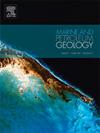The influence of Cenozoic fluid expulsion on the seafloor morphology of the Vulcan Sub-basin, northwest Australia: Implications of gas chimneys and linear diapirs for hydrocarbon exploration
IF 3.7
2区 地球科学
Q1 GEOSCIENCES, MULTIDISCIPLINARY
引用次数: 0
Abstract
The Vulcan Sub-basin on Australia's Northwest Shelf represents a Cenozoic tectonically active basin shaped by the collision of the Australian Plate with the Banda Arc. This study investigates the influence of fluid expulsion on this basin floor morphology, emphasizing gas chimneys and linear diapirs, through integrated analysis of 3D seismic data, seismic attributes (variance, RMS, and Sweetness), and stratigraphy. Results delineate two distinct gas chimney types: isolated structures in stable caprock regions and clustered features in tectonically weak zones, such as the Swan Graben. Chimney dimensions range from metres to kilometres, with origins traced to Eocene overpressure regimes in Palaeocene-Eocene carbonate reservoirs and vertical migration facilitated by fault reactivation. Also, five evolutionary stages are identified: Palaeocene-Eocene hydrocarbon accumulation, Oligocene overpressure generation, late Oligocene chimney initiation, Oligocene-Miocene sedimentary hiatus, and limited Miocene-Quaternary reactivation. Also, the absence of seafloor pockmarks implies rapid carbonate burial or ductile fluid migration without breaching, contrasting global analogues. Linear diapirs, aligned NE-SW, reflect stress regimes from the Australian-Eurasian collision, with spatial distributions controlled by tectonic segmentation and depositional heterogeneity. The Puffin Formation, a critical regional seal, exhibits spatially variable integrity, directly impacting hydrocarbon leakage and preservation. Notably, linear diapirs within clay-rich layers atop gas chimneys display unique seafloor morphologies shaped by tectonically influenced fluid venting, underscoring subseafloor morphogenetic processes. Clustered chimneys intersect Cenozoic strata, challenging conventional exploration models focused on pre-Cenozoic reservoirs. Seismic attributes reveal residual hydrocarbon potential in Paleogene sandstones and carbonates, particularly within structural traps in the Cartier Trough and Londonderry High. This study highlights the dynamic interplay of tectonics, overpressure, and sedimentation in governing fluid expulsion, offering a framework to de-risk Cenozoic prospects. The findings advance understanding of submarine fluid venting's role in seafloor evolution and provide insights applicable to convergent margin basins globally, while establishing a foundation for future studies on tectonic-seal-fluid interactions.
新生代流体排出对澳大利亚西北部Vulcan次盆地海底形态的影响:气烟囱和线状底辟对油气勘探的启示
澳大利亚西北陆架上的火神子盆地是由澳大利亚板块与班达弧碰撞形成的一个新生代构造活跃盆地。本研究通过对三维地震资料、地震属性(方差、均方根和甜度)和地层学的综合分析,探讨了流体排出对盆地底板形态的影响,重点研究了气烟囱和线性底辟。研究结果显示了两种截然不同的气烟囱类型:稳定盖层区的孤立构造和构造薄弱带(如天鹅地堑)的聚集特征。烟囱的尺寸从米到公里不等,其起源可追溯到古新世-始新世碳酸盐岩储层的始新世超压区,以及断层活化促进的垂直迁移。古新世-始新世油气成藏阶段、渐新世超压形成阶段、晚渐新世烟囱形成阶段、渐新世-中新世沉积间断阶段和中新世-第四纪有限的再活化阶段。此外,与全球类似物相比,海底麻子的缺失意味着碳酸盐的快速埋藏或韧性流体的迁移而没有破裂。线性底辟向NE-SW方向,反映了澳大利亚-欧亚碰撞的应力状态,其空间分布受构造分割和沉积非均质性控制。海雀组是一个重要的区域密封,其完整性在空间上是可变的,直接影响油气的泄漏和保存。值得注意的是,富粘土层内的线性底辟显示出独特的海底形态,这是由构造影响的流体喷发形成的,强调了海底的形态形成过程。簇状烟囱与新生代地层相交,挑战了传统的前新生代油气藏勘探模式。地震属性揭示了古近系砂岩和碳酸盐岩的残余油气潜力,特别是在Cartier海槽和Londonderry High的构造圈闭内。该研究强调了构造、超压和沉积在控制流体排出中的动态相互作用,为降低新生代前景风险提供了一个框架。这一发现促进了对海底流体喷发在海底演化中的作用的认识,并为全球辐合边缘盆地提供了适用的见解,同时为未来构造-密封-流体相互作用的研究奠定了基础。
本文章由计算机程序翻译,如有差异,请以英文原文为准。
求助全文
约1分钟内获得全文
求助全文
来源期刊

Marine and Petroleum Geology
地学-地球科学综合
CiteScore
8.80
自引率
14.30%
发文量
475
审稿时长
63 days
期刊介绍:
Marine and Petroleum Geology is the pre-eminent international forum for the exchange of multidisciplinary concepts, interpretations and techniques for all concerned with marine and petroleum geology in industry, government and academia. Rapid bimonthly publication allows early communications of papers or short communications to the geoscience community.
Marine and Petroleum Geology is essential reading for geologists, geophysicists and explorationists in industry, government and academia working in the following areas: marine geology; basin analysis and evaluation; organic geochemistry; reserve/resource estimation; seismic stratigraphy; thermal models of basic evolution; sedimentary geology; continental margins; geophysical interpretation; structural geology/tectonics; formation evaluation techniques; well logging.
 求助内容:
求助内容: 应助结果提醒方式:
应助结果提醒方式:


